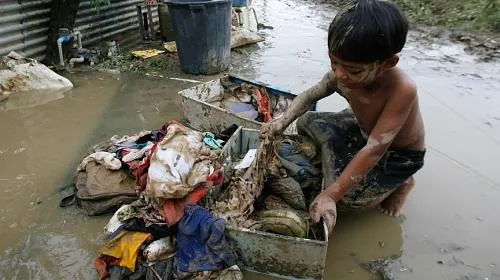CARE brings clean water, sanitation, shelter as official death toll tops 1,000 in disasters
CARE has deployed emergency crews in five Asian countries devastated by natural disasters, including an earthquake that crumbled parts of Indonesia and a pair of typhoons that spawned deadly flooding in Cambodia, Laos, the Philippines and Vietnam. An estimated $15 million USD is needed to provide humanitarian assistance in the affected countries. That includes $5 million in the Philippines, where 2.5 million people are either homeless or in need of emergency aid, and $5 million in Indonesia, where up to 4,000 are feared dead and far more are homeless.
Indonesian Earthquakes
CARE is part of a coordinated international effort to bring relief to the estimated 200,000 people affected by the 7.6 magnitude earthquake that hit the area on September 30th. “Getting supplies to survivors in these first few days is crucial,” said Adjie Fachrurrazi, CARE’s emergency response coordinator in Indonesia, speaking from the disaster zone. “Water sources have been contaminated or destroyed and this heightens the risk of disease for survivors. We must get clean water to them now.”
CARE is readying jerry cans and water purification kits for distribution, along with blankets, sarongs, hygiene kits, and materials to build community latrines. CARE’s emergency relief focus will be on the heavily damaged district and city of Padang Pariaman. Access to many areas in this region has been hampered by blocked roads and limited communications, yet CARE’s emergency team has been able to actively operate on the ground.
“Those people who survived are living with minimal supplies and no electricity,” Fachrurrazi said. “Although the road is still inaccessible in some areas, it is crucial that we reach them and deliver the relief.”
The current death toll stands above 700, but thousands more are feared buried under the rubble. Most of the survivors are staying outside in an open area, fearing to go back inside. Water pipes were destroyed along with sanitation facilities in most areas.
Limitations on water and sanitation have a disproportionate affect on women and children, who are the most vulnerable in the aftermath of disaster. Women, for example, have to care for their babies and young infants. To do so, they need to maintain their personal hygiene and ensure that the environment where they sheltered is keep clean, despite limited supplies and exposure to the elements.
CARE responded to similar earthquakes in the same area in 2007, providing water purification supplies and emergency shelter for 65,000 people. CARE will draw on the expertise of staff in Indonesia and the region to respond to the current disaster if needed.
Typhoons Ketsana and Parma
CARE’s largest emergency efforts in response to the typhoons are in the Philippines, where we are working with a local partner to distribute food, safe water, temporary shelter and emergency supplies. Our initial goal is to assist 30,000 people, with plans to reach 90,000.
CARE’s emergency response efforts also are continuing in Cambodia, Laos and Vietnam, where CARE has more than 230 staff on the ground. In Vietnam alone, initial government reports estimate that the typhoon has killed more than 100 people and damaged 300,000 homes. CARE is bracing for these initial estimates to rise significantly in the coming days.
Learn more about CARE’s response and read our blogs from the field.
About CARE: CARE is one of the world’s largest aid agencies, working in nearly 70 countries to fight poverty and helping more than 55 million people every year. CARE has been in Indonesia since 1967, Vietnam since 1945 and Laos since 1954. CARE operates a broad range of integrated projects in disaster risk reduction, emergency response, environment and natural resource management, health, livelihoods and water and sanitation.
Media Contacts:
Atlanta: Brian Feagans, CARE, bfeagans@care.org, +1.404.979.9453, +1.404.457.4644
Vietnam: Wiwik Widyastuti , CARE, wiwik_widyastuti@careind.or.id, +62.812.108.2491
Geneva: Melanie Brooks, CARE, brooks@careinternational.org, +41.79.590.3047

